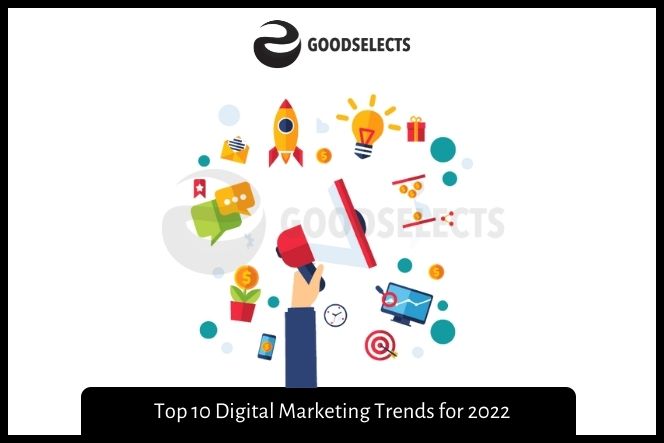In order to keep up with the latest trends in digital marketing, it is imperative to constantly evolve your strategies. Changing circumstances and consumers make it necessary for the latest trends to evolve and become standard practices. Here are the top 10 digital marketing trends to watch for in the next few years. Read on to discover what’s ahead in this year’s digital marketing world. Once you have adapted your strategies to these changes, you’ll be well on your way to staying ahead of the competition.
Influencer marketing
As a result, brands are investing more in influencer marketing, one of the top digital advertising trends in 2022. The ROI of influencer marketing is excellent – on average, $5.78 for every dollar spent – and it’s expected to continue. In fact, some brands are earning $18 for every dollar spent on influencer marketing. However, this ROI does not necessarily translate into more brand exposure.
Brands can leverage the power of influential individuals to increase their reach and generate new revenue. The use of influencers has evolved from being a tool to promote brand awareness. Today, influencers can provide brand information and social proof, which helps brands target customers at various stages of the sales funnel. The use of influencers can be leveraged to promote affiliate programs, live social shopping events, and promo code campaigns. The power of influencers is increasingly becoming scalable, and brands can scale the strategy as needed.
Despite the challenges of third-party data access, influencer marketing is set to remain one of the top digital marketing trends for 2023. This is due to the fact that 62% of iPhone users have opted out of app usage tracking. Furthermore, it allows brands to discover new channels and partners. A recent update on iOS 14.5 changed this decision, and it’s possible to surface new influencer marketing partners from their customer database.
Video marketing
According to a survey, video content is the number-one way consumers discover brands. Consumers rated videos as the #1 form of content they find helpful when shopping online. In addition, viewers are more likely to engage with video content across all social media platforms. And since video is a more engaging medium, marketers are more likely to see a return on investment with it. In fact, 96% of businesses have landed new customers after sharing videos on their social media channels.
Today, video content is critical to online marketing. In fact, 99 percent of marketers say that they’ll continue to use it. By 2022, the average US consumer will have 9.5 video-streaming apps on their smartphones. Additionally, video content will continue to be a major part of online strategy for a number of years to come. One of the latest trends in video marketing is shoppable videos, which let consumers buy products right on the spot.
Another digital marketing trend is video production. Compared to traditional forms of media, videos are more likely to be remembered. According to a Wyzowl study, people who view videos are three times more likely to remember a message than text content. The medium also is easier to invoke action-inducing emotion than texts. Another upcoming digital marketing trend is video advertising on messaging apps. This type of content is popular among consumers, and is more likely to attract clicks than a branded video.
Voice search
Voice search as a digital marketing trend for the year 2022 is here to stay. Using voice search as a marketing tool will allow you to capture the attention of your target audience by ensuring your content answers their questions. The semantic core of your site should include a series of relevant questions and individual phrases. A simple way to do this is to create FAQs on your website. By combining these two tactics, you’ll be able to convert more visitors into paying customers.
One of the most important aspects of voice search is the ability to tailor the search experience for the person using it. It can be a question or a long-tail keyword, as long as it sounds natural and conversational. When you optimize for voice search, keep in mind that Google wants relevant answers immediately, so be sure to tailor your content to be conversational and understand the needs of your target audience.
As voice assistants become more prevalent, they’re becoming more popular with Americans. Devices like Amazon’s Alexa and Google’s Home make it possible to speak into a voice assistant and conduct their search. By 2022, voice search will play a bigger role in digital marketing than ever, with revenues predicted to exceed $19 billion. In addition to enabling consumers to make purchase decisions without even having to pick up a device, voice assistants will become more effective at recognising individual voice and tailoring their search experiences to match their needs.
Adapting to changing circumstances
Adapting to change is a must in digital marketing. As the world around us becomes more technologically advanced and fast-paced, marketing strategies must be adapted accordingly to stay on top. In fact, Forbes recently identified the following trends that will impact digital marketing in 2022:
Customer-centricity is a key trend in this year. While 2021 was a year of embracing new technologies, this year will focus on continuing to improve marketing automation. Chatbots, for example, are examples of customer-facing technologies that use automation to help customers. As the market becomes more data-driven, so will digital marketing trends. While these trends will continue to evolve, you should be prepared for a challenging year ahead.
Adapting to changing circumstances is a digital marketing trend for 2022. This is due to the emergence of predictive data. According to Oracle, 88% of marketers believe that they will have access to the data they need to make sound decisions. Also, the use of social media and interactive content is a crucial part of content marketing strategies. In addition to content marketing, video marketing will also play an important role in inbound strategies in 2022.
Metaverse
As technology and marketing continue to evolve, brands are starting to turn their attention to the metaverse and its social features. Many of these brands are targeting Gen Z consumers, who spend more time on metaverse social networks than they do in the real world. They also have increased purchasing power. This is driving more brands to take advantage of the technology, such as Vans, who collaborated with Roblox to create a virtual skate park where users could practice their virtual skateboarding skills and buy Vans merchandise.
One trend emerging in this area is the use of gamification and exclusive products. According to research, 90 percent of users want to customize their avatars, so companies can use this strategy to entice them. This strategy has been successfully used by many big brands, such as Gucci. Avatars can be purchased for up to $4115, and brands like Digital Coutour can sell an avatar dress for $9500. These trends prove that consumers are willing to pay a high price for a digital product that they can customize themselves.
Once tech platforms figure out how the metaverse works, the future of digital marketing will look very different than it does today. For instance, video games and AR/VR are the precursors to the metaverse, which will offer marketers a new world to explore and experiment with. These new technologies are cheaper and less expensive to develop, so marketers will have more ways to take advantage of them. The benefits for brands are many and are worth considering.
AI predicts customer’s next move
A key aspect of online retail is knowing what customers want before they buy it. While most retailers require customers to place orders and ship them after they buy them, AI can make it possible for them to predict what customers will want before they buy. This means retailers can offer items without a formal order, giving them more freedom to return items if they are not the right fit. This can be an extremely effective way for businesses to retain their customers and increase sales.
Businesses like Netflix and Stitch Fix are already using AI to predict what their customers will like, allowing them to create better products based on what their customers are most likely to want. Businesses like these use the technology to predict what their customers will buy and when they will buy it. AI-powered algorithms can even predict weather, prices, and demand, and can even assist with shopping. This allows human agents to focus on more complex cases.
If AI can predict a customer’s next move, the impact on their sense of autonomy is unclear. Some early research suggests that customers are not familiar with artificial intelligence (AI) applications. For example, they do not associate AI applications with autonomous goals. Instead, they focus on the “how” rather than the “what” when engaging with an AI application. When they do engage with an AI application, they will be in a low-constructual mindset and may not be aware of their own preferences.




































